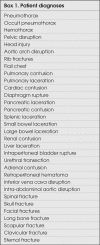Chest tube complications: how well are we training our residents?
- PMID: 18053373
- PMCID: PMC2386217
Chest tube complications: how well are we training our residents?
Abstract
Background: Thoracic trauma is commonly treated with tube thoracostomy. The overall complication rate associated with this procedure is up to 30% among all operators. The primary purpose of this study was to define the incidence and risk factors for complications in chest tubes placed exclusively by resident physicians. The secondary objective was to outline the rate of complications occult to postinsertional supine anteroposterior (AP) chest radiographs (CXRs).
Methods: Over a 12-month period at a regional trauma centre, we retrospectively reviewed all severely injured trauma patients (injury severity score >or= 12) who underwent tube thoracostomy (338/761 patients). Insertional, positional and infective complications were identified. Patients were assessed for complications on the basis of resident operator characteristics, patient demographics, associated injuries and outcomes. Thoracoabdominal CT scans and corresponding CXRs were also used to determine the rate of complications occult to postinsertional supine AP CXR.
Results: Of the patients, 338 (44%) had CXR and CT imaging. Out of 76 (22%) chest tubes placed by residents in 61 (18%) patients (99% of whom had blunt trauma injuries), there were 17 complications; 6 (35%) were insertional; 9 (53%) were positional and 2 (12%) were infective. Tube placement outside the trauma bay (p = 0.04) and nonsurgical resident operators (p = 0.03) were independently predictive of complications. The rates of complications according to training discipline were as follows: 7% general surgery, 13% internal and family medicine, 25% other surgical disciplines and 40% emergency medicine. Resident seniority, time of day and other factors were not predictive. Six of 11 (55%) positional and intraparenchymal lung tube placements were occult to postinsertional supine AP CXR.
Conclusions: Chest tubes placed by resident physicians are commonly associated with complications that are not identified by postinsertional AP CXR. Thoracic CT is the only way to reliably identify this morbidity. The differential rate of complications according to resident specialty suggests that residents in non-general surgical training programs may benefit from more structured instruction and closer supervision in tube thoracostomy.
Contexte: On traite communément les traumatismes au thorax par thoracostomie à drain. Le taux global de complications associées à cette intervention peut atteindre 30 % pour l'ensemble des chirurgiens. Cette étude visait principalement à définir l'incidence et les facteurs de risque de complications dans le cas des drains thoraciques mis en place exclusivement par des médecins résidents. Le deuxième objectif consistait à décrire le taux de complications occultes à une radiographie pulmonaire AP en supination après l'insertion.
Méthodes: Au cours d'une période de 12 mois, nous avons étudié rétrospectivement, dans un centre régional de traumatologie, tous les patients gravement traumatisés (score de gravité du traumatisme ≥ 12) ayant subi une thoracotomie à drain (338/761 patients). On a défini les complications liées à la mise en place, à la position et à l'infection. On a évalué les complications chez les patients en fonction des caractéristiques du chirurgien résident, des caractéristiques démographiques des patients, des traumatismes connexes et des résultats. On a aussi utilisé des tomodensitométries thoracoabdominales et des radiographies pulmonaires correspondantes pour déterminer le taux de complications occultes aux radiographies pulmonaires AP en supination après l'insertion.
Résultats: Parmi les patients, 338 (44 %) ont subi une radiographie pulmonaire et une tomodensitométrie. Des 76 (22 %) drains thoraciques mis en place par des résidents chez 61 (18 %) des patients (dont 99 % avaient été victimes d'un traumatisme contondant), il y a eu 17 complications dont 6 (35 %) étaient liées à l'insertion; 9 (53 %) à la position et 2 (12 %) à une infection. L'insertion du drain en dehors de l'unité de traumatologie (p = 0,04) et des médecins résidents non chirurgiens (p = 0,03) constituaient des prédicteurs indépendants de complications. Les taux de complications selon la discipline de formation étaient les suivants : chirurgie générale (7 %), médecine interne et familiale (13 %), autres disciplines de la chirurgie (25 %) et médecine d'urgence (40 %). L'ancienneté des résidents, l'heure du jour et d'autres facteurs n'étaient pas des prédicteurs. Des 11 drains pulmonaires positionnels et intraparenchymateux, 6 (55 %) étaient occultes à la radiographie pulmonaire AP en supination après l'insertion.
Conclusions: On établit couramment un lien entre des drains thoraciques insérés par des médecins résidents et des complications qui ne sont pas décelées par radiographie pulmonaire AP après l'insertion. La TDM pulmonaire est le seul moyen d'identifier fiablement cette morbidité. Le taux différentiel des complications selon la spécialité du résident indique que les résidents des programmes de formation en chirurgie non générale pourraient bénéficier d'une formation plus structurée et d'une supervision plus rapprochée dans le cas de la thoracostomie à drain.
Figures






References
-
- Livingston DH, Hauser CJ. Trauma to the chest wall and lung. In: Moore EE, Feliciano DV, Mattox KL, editors. Trauma. 5th ed. New York: McGraw-Hill; 2004. p. 507-37.
-
- American College of Surgeons, Committee on Trauma. Advanced trauma life support course for doctors instructor course manual. Chicago: American College of Surgeons; 2004.
-
- Blaisdale WF. Pneumothorax and hemothorax. In: Blaisdale WF, Trunkey DD, editors. Cervicothoracic trauma. 3rd ed. New York: Thieme; 1986. p. 150-65.
-
- Richardson JD, Miller FB. Injury to the lung and pleura. In: Feliciano DV, Moore EE, Mattox KL, editors. Trauma. 3rd ed. Stamford (CT): Appleton & Lange; 1996. p. 387-407.
MeSH terms
LinkOut - more resources
Full Text Sources
Other Literature Sources
Medical
